| Thursday, July 1, 2004 |
22:44 - The stripéd cow
|
(top)  |
I've had my first look at Tiger; there is much to be excited about, and much to rub one's chin about.
The biggest change about this new OS, the thing that's going to make the biggest difference in how we all work with our files and data, is Spotlight. This shouldn't be confused with the soft-focus-highlighting of items within System Preferences, though it's easy to do so; rather, Spotlight is a hugely ambitious database infrastructure that overlays the existing HFS+ filesystem (leaving all files intact in their original state), which lets the system add all kinds of new pieces of metadata to all files, folders, e-mails, and other groupings of data. This system is extensible, so developers can add new genres of criteria to their data as they go; the metadata fields are all data-type-specific. So, for instance, when you look at a digital photo in the Finder, you now see stuff like this:
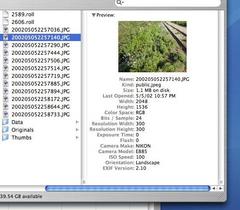
Check out all those data fields. Now... here's where things get squirmy. Yeah, it's cool... but with regards to technological prima nocte, this ain't an Apple coup. Windows XP has had this for years.
In fact, all of Spotlight can easily be seen to be a me-too-ism of what Microsoft has touted as its vision for Longhorn, currently slated for completion in 2006. Both systems involve databases that add huge amounts of contextual information to the pieces of data in the computer; Longhorn plans to use an SQL database to store all your data as well as just the metadata, dispensing altogether with the traditional filesystem we've all been used to, whereas Spotlight is just a separate layer on top of the existing legacy substrate. But different though the technical approaches may be, the end result is strikingly similar: tons more ways in which we can search, view, and group our files.
Think: Smart Folders.
Ahhhhh.
That's what this is all about: a new way of thinking about your data, in a metaphor other than simply "files" and "folders". I wrote about the potential for this a long time ago; the idea is that just as iTunes turns "MP3 files" in "folders" into songs in albums with artists, and iPhoto changes "JPEG files" to pictures in rolls and albums, the operating system should allow you to group your miscellaneous files just as flexibly. For instance, what if you wanted a "folder" that would always contain all documents—of whatever type—that contained the word "Apple" in them somewhere? With the addition of the Spotlight database, with its deep indexing of everything from movie files to PDFs to Word documents, you can now do that with what amounts to a single-line SQL query. And that query is now packaged as a "folder": a Smart Folder.
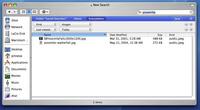
Not only that, but Spotlight adds all kinds of new fields of metadata that are filled out programmatically: Last Viewed being the most obviously useful. This field gets stamped whenever you open any document; then, you can tune your query to show you all documents with the word "Apple" in them that you've seen recently, or that you've never read; or you can add arbitrary query criteria, iTunes-style, to further fine-tune the search to only certain types of data (Word documents or PDFs, for instance), certain creation dates, and so on. You do your search, then click Save, and a new Smart Folder appears in your sidebar. Aha!
This is what they were rumoring about with those "Piles" that were supposed to be in Panther. As implemented in Tiger, they look like folders (they get stored in "Saved Searches" in your home folder), but they act like database queries—the same way playlists and Smart Playlists in iTunes work. And, indeed, this is what Microsoft has been trumpeting as the future of computing for some time now.
Has Apple copied Microsoft? I rather doubt it; this technology is quite well advanced, even in this early beta. They've obviously been working on this for some time now—years at the least. Indeed, it was about three years ago that Apple hired Dominic Giampaolo and Pavel Cisler, the filesystem gurus fleeing the sinking ship of Be, home of the awesomely flexible and extensible BeFS; we all expected great things to be immediately forthcoming, such as extended metadata within UFS, the return of Type/Creator codes, journaling, and so on. Journaling did show up, but nothing else; we figured that this was an effort that had fizzled. But now, it seems, they were just waiting to get it right before they folded in this new system that's big enough to Change Everything™.
Here's what happens when you do a global search now, using the magnifying-glass icon in the upper right of the menu bar (and click the first option in the type-sorted list, Show All Results):
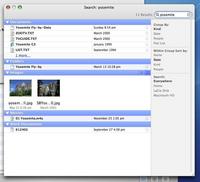 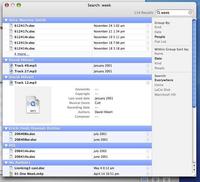
You can sort your results in a number of ways using the new criteria: two levels of sort ordering, using fields such as Person (the Author field gleaned from Word documents, for example), and with various view options for types such as Images. Clicking the "i" icon on any result shows you all the criteria that Spotlight knows about for that file: ID3 tags for music, image dimensions for pictures, and all that rot.
Alert viewers will notice that these screenshots show an interface whose designers have tried reeeally hard to keep it from looking too much like Windows XP, let alone alphas of Longhorn. Just put the sidebar over on the left, and you'll have a hard time convincing anybody that this wasn't a direct crib. But really, it's only the surface layout and presentation that are similar (and hey, Microsoft has a fairly good implementation where this kind of paradigm appears); the underlying technologies are mature enough to indicate that this is a case of parallel development. Microsoft has crowed about Longhorn more, but Apple has quietly got there first.
I certainly can't blame either company for wanting to go this route. Clearly someone in the development teams of both companies is database-happy; I know what that's like. Once you've done database programming, everything starts to look like a database problem. Surely there were plenty of developers in both companies with enough experience doing web apps and working on sexy things like iTunes that there was a groundswell of desire to see the whole computing experience driven by the elegant concept of the query, backed by as rich a data store as possible.
This is not, however, to suggest that this is entirely the work of seasoned, greybearded UI designers with a grand master plan. It's probably quite the opposite. The database concept is a fairly new thing to see married to UI; and the youth and energy that's present in Apple right now seems to have been manifested in Dashboard, another of the new flashy features in Tiger.
Dashboard, which is rightly identified as a Konfabulator clone, is nonetheless implemented in such a way as to be immediately more useful than Konfabulator—and to solve a problem as old as the computer. Namely: where the hell do tiny little meta-meta-apps, like the calculator, the floating analog clock, and the day-planning calendar, go?
There's never been an elegant answer to this. When I want to use the calculator, on Windows I have to dig down into the spooky depths of the Accessories branch of the Programs menu. Mac OS 9 and earlier put it in the Apple menu; but when that was cleaned up for Mac OS X, Apple needed a new paradigm. "I know!" they said. "We'll put it in the Dock!" Or, in the case of the Clock, "We'll just have it floating around all the time!" Bzzzt. Bad ideas. People don't want floaters, more than absolutely necessary; and things like calculators shouldn't be floaters. We don't want to have to launch individual apps to get such piddling little things done. I've never used Stickies in Mac OS X, though it was indispensable to me in OS 9, because it seems absurd to have to keep it in my Dock and treat it as another application to run during my session. Furthermore, one of my shameful secrets is that when I want to do some calendar planning, for instance when I want to see what the date is of next Friday so I can put it on a schedule, I scoot over to my Windows machine and pop up the calendar from the systray. That's the quickest software calendar available to me; the only way I can do anything like that on the Mac is to have iCal running all the time (which is teh suck on a 15" iMac), or to use "cal" on the command line.
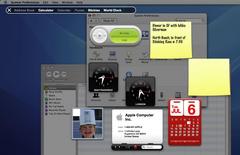
Finally we have our answer. Just as Exposé finally solved the age-old problem of how to pick a window from a z-layered stack, Dashboard solves the problem of where to put the friggin' Desk Accessories. Just press F12 and they all swoop into view, using a Quartz effect that's only the beginning of the roller-coaster ride your eyes are about to be taken on. You get a floating dark gray toolbar with the names of "gadgets" (or "widgets"—they haven't yet made up their minds); click on one, and the gadget in question leaps into being. On a G3 iBook, the applet simply appears; but on a G5, the following startling effect announces the arrival of the new tool:
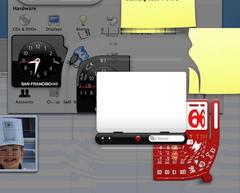
It splats onto the screen, creating a water-ripple effect that spreads out from the point of impact, lasting for several seconds as the applet gathers its content (from the net or from other running apps). This is where one starts to feel that Dashboard is in its adolescent demoware phase; as one continues to use it, and more such effects make their presence known (the "suck" effect is back, for when you close an applet—and when you access the preferences on one, it smoothly flips around in 3D space and shows you the controls on its backside), one starts to hope Dashboard will pass through puberty quickly and silently.
What it'll have to grow out of is this:
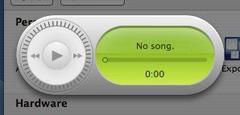
The iTunes control. This is quite obviously the child of somebody a little too big for his graphic-designing britches. Sure, it looks damned cool; but look closer. What's this designed to resemble? The iPod. There's the thumbwheel. There's the ring. There's the LCD-like green color. What do you suppose lies behind the design of this item? Why, it's our good old friend Software... that looks like THINGS! Long ridiculed by the Interface Hall of Shame (seems no longer to exist, fooey) back in the days of QuickTime 4, this interface aspiration attempts to make the controls of pieces of software resemble the controls of actual, physical devices. The QuickTime 4 player, in the classic example, had a thumb-wheel for the volume control. A perfectly usable piece of interface in the real world... but not in software. Why try to recreate in software a patently physical interface element that's designed to cope with the constraints of physicality, when in the virtual world your constraints have to do with the mechanism of interaction with screen elements rather than the construction of the elements themselves? To adjust the volume in QT4, you had to click in the vicinity of the scroll wheel and drag up or down to "rotate" the wheel. You had to make several "drags" to get the volume to move through its whole scope of travel. This was ridiculously clumsy and limiting, and the QT developers sensibly replaced the volume control with a simple slider in QT5.
But now we have this iTunes controller in Dashboard, with iPod-style Play/Back/Forward buttons, and... look at that ring around them. See those little radial lines, that look like a knurl? They appear when you mouse over the controls, while iTunes is running. Know what the ring is? That's right: A volume control. you have to click, hold, and then drag around in a circle to control the volume. A more retarded thing to ask a mouse user to do I simply cannot imagine—not when iTunes itself has such a sensibly designed, software-native, human-friendly, intuitively obvious interface, built right into its existing floater.
I can fully understand the need to flesh out the list of Dashboard widgets so as to present a breathtaking demo. However, this iTunes controller is ill-conceived and a giant leap backward in the heretofore sterling career of the iTunes/iPod duo, whose popularity is owed in no small part to their user-interface paradigms that, while entirely unlike each other, are natively intuitive to their respective media: iTunes using well-understood software motifs, iPod using revolutionary real-world finger controls. There's no need to muck with success; let's limit Dashboard to what is genuinely useful, and let's give all of the Apple-supplied widgets the proper design attention, instead of delivering flashy but perfunctory demoware. (Put an AM/PM indicator on the World Clock, for Pete's sake.) After all, once Konfabulator's widgets start being ported, there will be no shortage of things to put up there in F12-space.
Needless to say, the poor G3 iBook couldn't handle the eye-candy effects of Dashboard (with the exception of the magnify-in/out and the "suck" close effect), so Tiger doesn't even try. I don't know whether those effects, which clearly require Quartz Extreme (the iBook also showed some very bad layering problems, with bounding boxes flickering into view as I moved the widgets around—unheard-of in the world of Quartz compositing), are present on G4 machines. This is obviously a feature designed to sell G5s, and to start ramping up the hardware requirements of upcoming operating systems. The OS X versions from 10.1 on have showed a remarkably exceptional behavior: each successive one has been less demanding, as a result of ongoing optimization, of hardware; so Panther (10.3) can run much more comfortably on modest G3 hardware than 10.0 (Cheetah) or 10.1 (Puma) ever could. But Tiger seems determined to reverse that trend; and while G3-based machines are still listed as eligible in the requirements box, it's clear that they're about to be dropped off the lower rung before too long. While the G5-stroking Dashboard effects are definitely the kind of things that make my leg start to shake involuntarily, I'm not so sure they're worth making the OS run so slowly on my iBook. But then, there's an awful lot of debug code in this very early developer preview, and it's bound to get faster; besides, as mentioned, they've carefully omitted the special effects that the G3 can't handle, and Dashboard is just as usable, if presently not very responsive, without them.
So: Tiger is Apple setting out in a few new directions, not all of which I'm entirely at ease with just yet. This is the kind of OS put out by a company feeling its oats; it's a very confident sort of system, one that's not afraid to start hacking at the jungle vines defining the borders so as to make some serious aggressive inroads against any potential customers likely to be wowed by eye-candy. Now that Apple can get away with it, with the G5, they're starting to squeeze and see how much juice drips out. At the same time, Spotlight is likely the biggest change we've seen in how we're to think of navigating our computers since the advent of the files-and-folders metaphor; it provides for full backward compatibility in users' hearts and minds, but it takes no prisoners in its bid to expand iTunes-style querying and organizing beyond mere apps and into generalized data. It's going to take some getting used to, but an awful lot of people are going to discover that the functionality it provides is the kind of stuff that we won't be able to imagine ever doing without.
UPDATE: Also, interestingly, the Tiger installer comes on a DVD, and thus requires a DVD-capable drive. This can mean either that a) Apple is planning to exclude all non-DVD-drive Macs from Tiger compatibility for some inadequately clear reason, or b) this is just for the beta program, so they can discourage people from downloading and burning ISO images of the installer, as DVD blanks are still much more expensive than CDs. My guess is that it's the latter...
UPDATE: John Gruber of Daring Fireball preemptively lashes out against Dashboard/Konfabulator "ripoff" complaints:
A sliding puzzle. A calculator. A clock. A little notepad. Tiny little applets — little pieces of software that are something less than full applications themselves, but which run alongside real apps and are easily accessed at any time.
Obviously, Apple ripped off the idea for Dashboard. Stolen wholesale, without even the decency to mention where they took the original idea.
Which, of course, would be the desk accessories from the original 1984 Macintosh — conceived by Bud Tribble and engineered (mostly) by Andy Hertzfeld.
It also sounds, from his description of the Dashboard panel at WWDC, that there'll be no shortage of excellent widgets in the shipping version of Tiger and immediately available third-party. These ain't the final ones—not remotely.
|
|
 Brian Tiemann
Brian Tiemann








